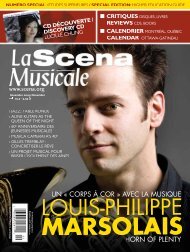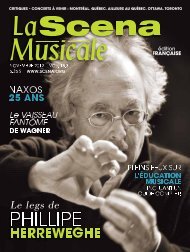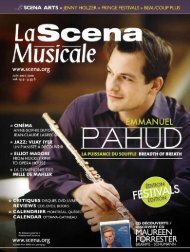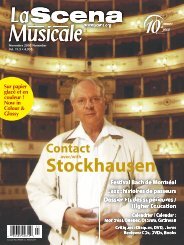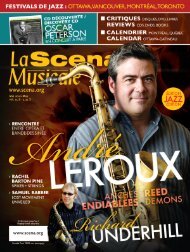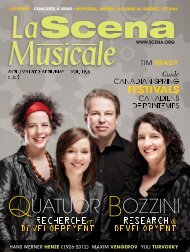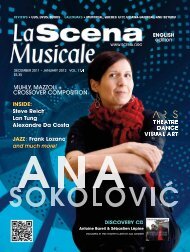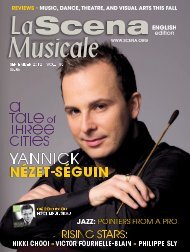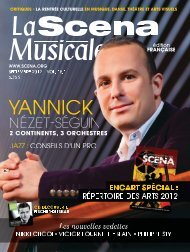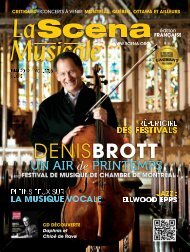Create successful ePaper yourself
Turn your PDF publications into a flip-book with our unique Google optimized e-Paper software.
Le nouveau pavillon de la faculté de musique de l’Université McGill<br />
Une architecture éloquente au<br />
service de la musique<br />
McGill’s New Music Building:<br />
A Resounding Success<br />
<strong>La</strong>urier Rajotte<br />
Vous l’avez peut-être vu ouvrant fièrement le campus au<br />
flanc est de l’une des institutions les plus prestigieuses<br />
au pays, le nouveau pavillon de musique de l’Université<br />
McGill s’impose sur la scène internationale comme un<br />
fleuron de la technologie au service de la musique et du<br />
son. D’abord élaboré en 1994 pour accueillir la bibliothèque de la<br />
faculté, le projet d’un nouvel édifice a vite pris, sous la direction<br />
du doyen Don McLean, une tournure beaucoup plus ambitieuse.<br />
« En plus de la bibliothèque, l’idée d’un grand studio d’enregistrement<br />
s’est imposée d’elle-même. On prévoyait construire des<br />
espaces de répétition assez grands pour les musiciens, mais pas<br />
assez grands pour obtenir un bon niveau de qualité sonore. Vers<br />
1995, les profonds changements dans les technologies du<br />
son, comme la sensibilité des micros, nous ont également<br />
incités à ajuster notre tir. Si l’on voulait utiliser cet espace<br />
pour des enregistrements et particulièrement pour de<br />
la recherche sur les techniques d’enregistrement, les<br />
paramètres acoustiques d’un studio devaient être parfaitement<br />
maîtrisés. » C’est ainsi que le doyen de la faculté de<br />
musique visita et étudia les meilleurs studios d’Hollywood<br />
dans le but de construire ce qui est aujourd’hui un grand studio<br />
d’enregistrement à l’avant-garde des plus hauts standards internationaux,<br />
ici, à Montréal.<br />
Un centre de recherches multidisciplinaires à construire<br />
L’opportunité de réunir plusieurs domaines de recherche dans un<br />
studio aussi prometteur n’a pas été repoussée : trame cinématographique;<br />
application multimédia; enregistrement, technologies<br />
et génie du son; neurosciences; autant de disciplines concernées<br />
par un tel espace. « Les recherches étant déjà très dynamiques<br />
dans notre faculté, il m’apparaissait évident de réunir les chercheurs<br />
dans un même endroit pour leur donner accès à des outils<br />
plus performants », précise Don McLean. Leur art utilisant souvent<br />
les outils les plus perfectionnés, on n’a qu’à penser aux<br />
orgues de Bach, aux pianos de Beethoven, voire au Poème électronique<br />
de Varèse, les musiciens ne sont pas les plus difficiles à<br />
convaincre quant à l’importance d’utiliser les meilleures technologies.<br />
C’est ainsi qu’avec cette volonté d’approfondir la compréhension<br />
de la création, de la transmission et de la production<br />
musicale et sonore est né le centre de recherche CIRMMT (prononcé<br />
Kirmit, Centre for Interdisciplinary Research in Music<br />
Media and Technology) jouissant maintenant d’un nouvel outil de<br />
recherche que représente le studio d’enregistrement.<br />
An impressive new centre for McGill’s faculty of music has<br />
risen on the southeast corner of the campus of the prestigious<br />
university. The building’s innovative design puts architecture<br />
to work for cutting-edge recording technology and<br />
acoustics, and it is sure to elevate the international reputation<br />
of the faculty and Montreal’s music community. In 1994, a new<br />
building was planned to house the music library, but under the guidance<br />
of the dean of music, Don McLean, the project grew quickly into something<br />
much more ambitious. “As well as conceiving the library,” he says,<br />
“we felt there was an obvious need for a large recording space. We had<br />
plans for rehearsal rooms big enough for the musicians but not big<br />
enough to give us good natural sound quality. Around 1995 there were<br />
some major improvements in recording technology – more sensitive<br />
microphones, for example – and we were inspired to aim a<br />
little higher. We hoped to create a space not just for recording<br />
but for research into recording techniques and science; and to<br />
do that we had to have a space whose acoustic parameters<br />
were completely under our control.” In preparation, McLean<br />
visited and studied the best sound studios in Hollywood with<br />
the goal of building, here in Montreal, a recording studio that<br />
could rival or surpass the highest international standards.<br />
A Centre for Multidisciplinary Research<br />
The designers did not shy away from the chance to align several<br />
different research fields into a single, ambitious studio plan. Film soundtracks,<br />
multimedia applications, music recording, studio technology,<br />
sound engineering and even neurosciences have a home in the new<br />
space. “Since the faculty already had some dynamic talents in these<br />
areas of research, it seemed logical that the researchers share a single<br />
facility where they could get their hands on the best tools available,”<br />
stresses McLean. Since musicians naturally gravitate towards the most<br />
powerful instruments they can find – think of the organs of Bach, the<br />
pianos of Beethoven or the electronic experiments of Varese – it’s not<br />
hard to convince them that cutting-edge technology is a must. So at the<br />
heart of the building project was a strong desire to deepen students’<br />
understanding of musical creation, production and transmission – a<br />
complete spectrum of the sonic arts. The result is the Centre for<br />
Interdisciplinary Research in Music Media and Technology (or CIRMMT,<br />
pronounced “Kermit”), where students and professors can take advantage<br />
of a new recording studio to broaden their research projects.<br />
The Montreal-based firm MDSL Architectes, which used highly<br />
innovative techniques, such as the box-within-a-box design that prevents<br />
any outside vibrations from affecting the studio's acoustics, car-<br />
18 octobre 2005 october





